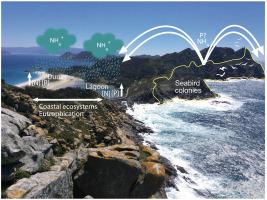Chemosphere ( IF 8.1 ) Pub Date : 2021-02-24 , DOI: 10.1016/j.chemosphere.2021.130077 S. De La Peña-Lastra , A. Pérez-Alberti , X.L. Otero

|
Seabirds form large colonies during the reproductive period, producing substantial changes in coastal ecosystems. The present study quantifies the amount of N and P deposited in colonies of yellow-legged gull (Larus michahellis) in the Atlantic Islands of Galicia National Park (AINP). Based on the composition of droppings, the amount of total N (TN), total P (TP) and bioavailable P (Pbio) deposited directly on the area occupied by the colony was determined. In addition, the amount of NH3 released into the atmosphere was also estimated by applying a bioenergetic model. The results indicated that 5.35 t total N, 3.35 t total P and 1.24 t bioavailable P are deposited in the colony annually. The archipelagos that received the greatest amount of nutrients were the Cíes Islands (2.37 t TN y−1, 1.48 t TP y−1, 0.55 t Pbio y−1), Sálvora (1.94 t TN y−1, 1.22 t TP y−1, 0.55 t Pbio y−1) and Ons (1.04 t TN y−1, 0.65 TP y−1, 0.24 t Pbio y−1). Rainwater from the colonies showed higher values of nutrients than in the control plot, possibly also due to gull influence. Therefore, the yellow-legged gull colony seems to be the most important source of nutrients at a local level, exerting a clear influence on the N and P cycles in this National Park. Another aspect worth taking into consideration is that increased N and P bioavailability may have a negative effect on the conservation of rare or threatened habitats and species by promoting the expansion of non-native ruderal species.
中文翻译:

海鸟殖民地是加利西亚国家公园(西班牙西北部)大西洋群岛沿海生态系统的主要养料来源
海鸟在繁殖期形成大的殖民地,在沿海生态系统中产生了巨大的变化。本研究定量分析了加利西亚国家公园(AINP)大西洋群岛的黄足鸥(Larus michahellis)菌落中的N和P含量。根据粪便的成分,确定直接沉积在菌落占据区域的总氮(TN),总磷(TP)和生物利用磷(Pbio)的量。另外,还通过应用生物能模型来估计释放到大气中的NH 3的量。结果表明,该群体每年沉积总氮5.35 t,总磷3.35 t和生物利用度1.24 t。吸收营养物质最多的群岛是西埃斯群岛(2.37 t TN y-1,1.48吨TPÿ -1,0.55吨PBIOÝ -1),Sálvora(1.94吨TNÿ -1,1.22吨TPÿ -1,0.55吨PBIOÿ -1)和增强模块(1.04吨TNÿ -1,0.65 TPÿ -1,0.24吨PBIOÿ -1)。来自殖民地的雨水显示出比对照地块更高的养分值,这可能也是由于海鸥的影响。因此,黄腿鸥群似乎是地方一级最重要的养分来源,对这个国家公园的N和P周期产生了明显的影响。值得考虑的另一个方面是,氮和磷的生物利用度的提高可能通过促进非本地鱼物种的扩张而对稀有或受威胁的生境和物种的保护产生负面影响。











































 京公网安备 11010802027423号
京公网安备 11010802027423号